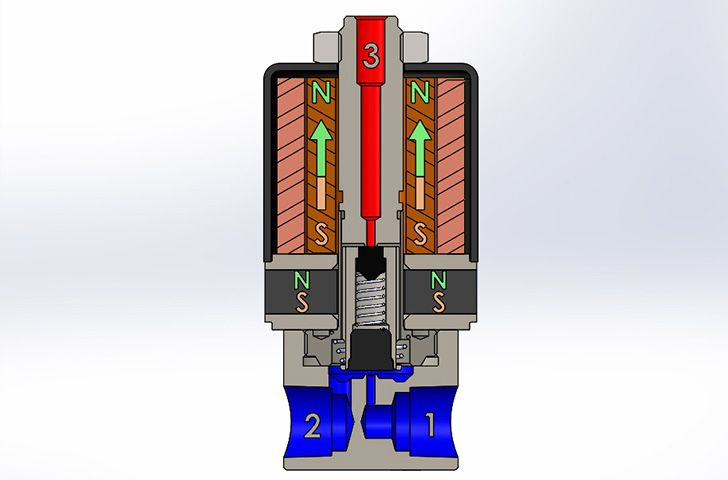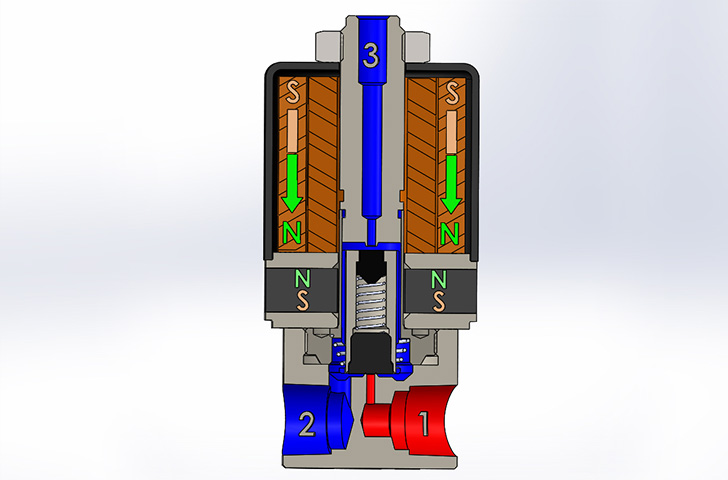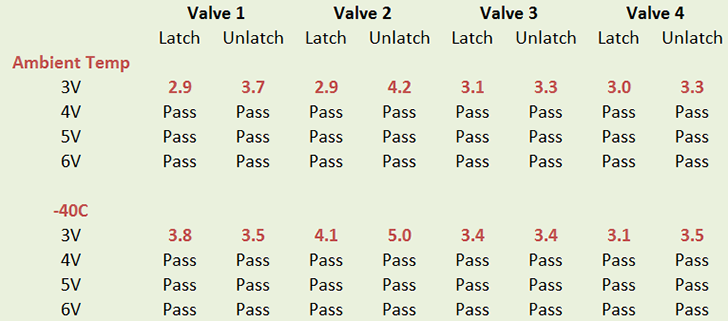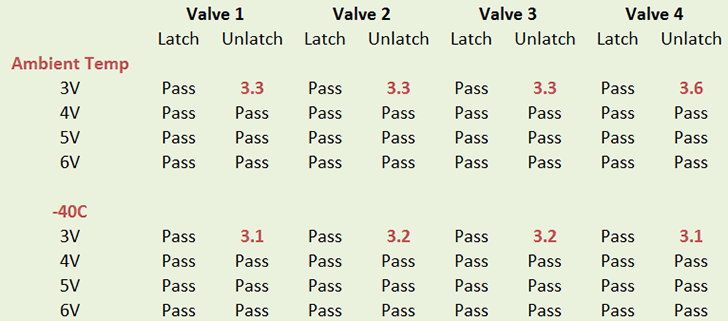Our 25th Anniversary Edition - Read Now!
View Past IssuesLatching valves, which control the open and closed states of plunger lift systems used in shale drilling for natural gas, can be the cause of tremendous anxiety and great expense for energy producers if they fail to perform consistently to expectation.
Users have identified two primary reasons for latching valve failure. The first is local operating conditions. In cold, dry environments, many have experienced what they believe to be “freezing” of latching valves.
Users have identified two primary reasons for latching valve failure: lack of sufficient solar power to adequately pulse the valve, and what is believed to be “freezing” in cold climates.
The second reason for failure is attributed to lack of sufficient energy to open or close the valve when necessary. In remote areas, where energy sources are generated primarily by solar power, minimal voltage may be available to operate the valves. If the valve is not able to perform effectively at lower voltages, the gas line may remain open and become flooded with water.
Both causes of failure have been overcome through design engineering – by altering the valve’s magnetic fields and by designing valve components with sufficient mass to optimize response to magnetic pull.
Plunger lift systems efficiently and cost-effectively deliquify gas wells to maximize the gas-to-liquid ratio. Regular fluid removal allows the well to produce gas continuously and prevent fluid loading that periodically halts gas production or kills the well entirely. Plunger lift systems can conserve the well’s lifting energy and increase gas production.
Latching solenoid valves are at the heart of a plunger lift system.
Modern wellhead controllers offer a variety of methods to control the plunger. Today’s latching valve is ideal in functioning as the pilot valve for large, pneumatic valves, which, in turn, control the open and closed states of plunger lift systems. Latching solenoid valves are designed to allow the valve to remain either open or closed without continuous power. The term “latching” refers to the valve in its open state condition, during which supply pressure goes to the external valve. The “unlatched” valve refers to its closed state condition where the external valve is vented to the atmosphere.
Historically, latching valves have typically failed in an open position where the external valve is pressurized, leaving the well open and allowing water to be introduced into the gas pipe. If this occurs, managers are forced to cease production of the well and call upon a service person – who may require a day or even two to arrive on site. The aggregate cost of the technician, production stoppage and lost time can amount to tens of thousands of dollars. One report estimates this figure to be in excess of $30,000 per incident.
A malfunctioning latching valve can result in $30,000 in service costs and lost production time of a well.
A latching valve is comprised of a plunger, a stainless steel guide tube in which the plunger rides, a return spring, two magnetic coils and a permanent magnet. Through the use of a permanent magnet, the valve stays in an open or latched state. The valve closes when the return spring pushes the plunger down and closes the valve.
A 50 millisecond DC voltage is applied to reverse the magnetic polarity and move the valve from the open to closed position or vice versa.
Under this design, the valve remains in either an open or closed state indefinitely without requiring power. This feature makes the valve suitable for use in remote areas where continuous power may be limited.
To move the valve from one state to another, a short, 50 millisecond DC voltage is applied to one of the two coils. To shift the valve back, a DC pulse is applied to the other coil. To enable the plunger to lift and move the valve to an open state, the inner coil is energized, thereby creating a magnetic field that overcomes the return spring and lifts the plunger. The incoming well pressure also aides in lifting the plunger.

Valve Latched: A 50 millisecond pulse is applied to the inner coil creating a magnetic field that pulls with the permanent magnet’s field lifting the plunger into the latched position. The plunger is held indefinitely in this position by the permanent magnet. Flow is maintained between ports 1 and 2.

Valve Unlatched: A short pulse to the outer coil creates a magnetic field of opposing polarity to the permanent magnet. This temporarily cancels the two fields allowing the plunger to return to the unlatched position via a return spring. Flow is maintained between ports 2 and 3.
To ensure the plunger falls quickly and closes the valve completely, it is necessary to apply a magnetic field sufficient to cancel the permanent magnet’s field and allow the return spring to push the plunger down against incoming pressure.
For years, users have reported experiencing a higher valve failure rate during extreme cold conditions. Most times, this failure occurs when the valve is in a latched state and the well line is open. But, what many have perceived as “freezing,” may simply be a matter of increased friction.
Does the shape of a valve’s plunger influence its failure rate? Some latching valve manufacturers have chosen to design a hexagonal-shaped plunger in the belief that, because it contains less surface area than a round plunger, it decreases the opportunity for the plunger to freeze to the guide tube. But, is moisture on the plunger and subsequent freezing to the casing truly the cause of valve malfunction in cold weather or might there be another cause?
The key to preventing valve failure would seem to be to center the plunger within its guide tube to minimize friction and prevent what is believed to be “freezing” of the plunger.
When the latching valve is unlatched, the permanent magnetic field is cancelled, causing the return spring to drop the plunger. Since the voltage applied to the valve may be lower in cold temperatures due to battery storage capability or solar power limitations, the cancelling magnetic field applied is less than ideal and the plunger grazes the walls of the guide tube. But, what if the permanent magnetic field could be cancelled to the point where the plunger falls freely down the center of the guide tube and does not come into contact with the side walls? Less friction would result, meaning, as the spring worked to push the plunger down against incoming pressure, the less resistance it would encounter. In this case, the argument for a hexagonal-shaped plunger is nullified.
If friction, and not freezing, is truly the cause of valve malfunction in cold temperatures, is there any other benefit to using a hexagonal-shaped plunger? A hexagonal plunger appears to be less than ideal for two reasons. Its first weakness is that it inherently contains less mass upon which a magnet can pull, thereby making it less efficient. Its second shortcoming is related to cost. A hexagonal plunger is more costly to produce because it contains multiple cuts and therefore requires higher machining costs.
A hexagonal plunger inherently contains less mass upon which a magnet can pull, thereby making it less efficient.
Latching solenoid valves are ideal for applications where power is limited. Continuous power is not required to ensure the permanent magnet holds the valve in the energized position. As previously stated, only a short DC voltage is applied to the magnetic coil to shift the valve’s state from open to closed or vice versa.
In cold, cloudy conditions, there may not be sufficient sun to generate the solar power required to adequately recharge the batteries responsible for pulsing the coil. Therefore, it is best for a latching valve to function under the lowest possible force/voltage. If a valve is intrinsically designed to minimize friction, less power is required to operate the plunger in either direction, particularly in extremely cold conditions.
If a valve is intrinsically designed to minimize friction, less power is required to operate it, particularly in extremely cold conditions.
For example, if a wellsite controller is rated to require six volts, but, because the sun’s rays are lacking, the solar panel is able to generate only four volts to charge the battery, will the voltage be sufficient to cancel the magnet and cause the plunger to close the valve as required? Ideally, one would want the valve to operate effectively with a minimum of five or even four volts of power. In fact, most plunger lift controllers cease to function if fewer than four VDC are available.
Ideally, if a wellsite controller is rated to emit six volts of power, the latching valve should operate effectively under only four or five volts of power.
To determine if the shape of the plunger influences its performance, hexagonal-shaped and round plungers were tested in ambient temperatures and at -40°C (-40°F).
In ambient temperatures, both round and hexagonal plungers operate effectively at four to six VDC (voltage direct current) without issue.
In tests conducted in -40°C temperatures, round plungers operate at a much lower average minimum voltage than do hexagonal plungers due to their additional mass.
In tests conducted at -40°C, both round and hexagonal-shaped plungers appear to work as expected when 4-6 VDC are applied; however, round plungers operate at a much lower average minimum voltage than do hexagonal plungers (3.1 vs. 3.7 VDC, respectively) making them a better choice for drill sites challenged by a lack of sun.
Hexagonal Plunger

Round Plunger

Historically, two causes have been cited for plunger valve malfunction in cold climates: freezing of valves and lack of sufficient energy to pulse the valve from an open to closed state or vice versa.
However, tests have shown that, during extremely cold temperatures, latching valve malfunction may not be due to condensation and subsequent freezing of the plunger to the guide tube, as previously surmised. In fact, failure is the result of increased friction or drag brought on by the inability of the coil’s magnetic field to cancel the opposing magnetic field completely. Because the voltage applied to the valve is often lower in cold temperatures due to battery storage capability or solar power limitations, the cancelling magnetic field applied is less than ideal and the plunger grazes the walls of the guide tube. Latching valves designed for optimal performance in extreme cold conditions ensure the plunger is centered within the guide tube, thereby eliminating friction and preventing drag. This is achieved by altering the magnetic field and reducing the residual force of the guide tube on the plunger, allowing the spring to successfully push the valve closed.
Some also believe latching valves with hexagonal-shaped plungers perform best because they have less surface area available to come into contact with the guide tube, therefore, less opportunity for freezing exists. However, when the plunger is centered within the guide tube and does not touch its side walls, perceived “freezing” or drag is eliminated.
Moreover, tests show that hexagonal-shaped plungers are inferior to round plungers in low voltage situations because they contain a lower overall mass and are, therefore, less responsive to magnetic pull. In addition, valves containing hexagonal-shaped plungers are more costly simply because additional machining is required during the manufacturing process.
To explore ways to optimize the performance of your plunger-lift system using high performance latching valves, contact your local Gems Sensors & Controls sales professional.
Founded in 1955, Gems is a preferred supplier to thousands of OEM companies across a broad range of industries throughout the world due to its extensive application knowledge, innovative sensor and miniature solenoid valve designs, and customer-centric approach to problem solving to meet customer-specific needs.
Gems Sensors & Controls is a leading global manufacturer of: liquid level, flow, and pressure sensors; solid-state relays and barriers; liquid and pneumatic miniature solenoid valves; and pre-assembled fluidic systems, with facilities in North America, Europe, and Asia. Gems Sensors & Controls is ISO 9000 Registered, UL and CSA recognized, and provides CE Marking for applicable products as required.
For additional product information, contact Gems Sensors & Controls, One Cowles Road, Plainville, Connecticut 06062. Phone: 800.378.1600 or visit www.GemsSensors.com
Did you enjoy this article?